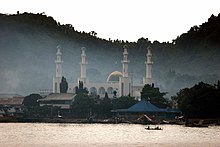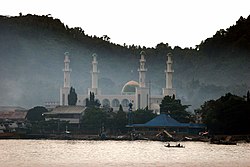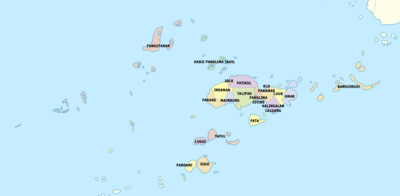|
Sulu
Sulu ([sʊˈlu]), officially the Province of Sulu (Tausūg: Wilāya sin Lupa' Sūg; Tagalog: Lalawigan ng Sulu), is a province of the Philippines in the Sulu Archipelago. It was part of the Bangsamoro Autonomous Region in Muslim Mindanao (BARMM), until the Supreme Court of the Philippines on September 9, 2024 declared its inclusion to be unconstitutional because of the province's simple majority vote against it during the 2019 Bangsamoro autonomy plebiscite.[4] Its capital is Jolo on the island of the same name.[5] Maimbung, the royal capital of the Sultanate of Sulu, is also located in the province. Sulu is along the southern border of the Sulu Sea and the northern boundary of the Celebes Sea. Out of all 82 provinces in the Philippines, it is the poorest, as evidenced by it having the highest poverty rate.[citation needed] According to the Philippine Statistics Authority, poverty incidence in Sulu had reduced in 2021 with 51 percent compared to 75.3 percent in 2018. According to the PSA, this reduction in poverty incidence is an improvement for the province.[6] HistoryEarly historyPrior to the arrival of Islam in Sulu, the province used to adhere to local animist religions; this later changed to Hindu and Buddhist belief systems. Throughout this time, the Kingdom of Lupah Sug had been established centuries before Islam arrived. The advent of Islam around 1138 through merchants and traders had a distinct influence on Southeast Asia. The coming of Arabs, Persians and other Muslims paved the way for the arrival of religious missionaries, traders, scholars and travelers to Sulu and Mindanao in the 12th century.  A landmark born of the social process was the founding of the Sultanate of Sulu. Year 1380 CE, The Sunni Sufi Scholar Karim-ul Makhdum came to Sulu and introduced Islam to the Philippines. In 1450 CE, Johore-born Arab adventurer Sayyid Abubakar Abirin came to Sulu and lived with Rajah Baguinda Ali. The Sunni Sufi Teacher and Sayyid Abubakar eventually married Ali's daughter, Dayang-dayang Paramisuli, and inherited Rajah Baguinda's polity (which was a principality before), which he turned into the Sultanate of Sulu and become its first Sultan. To consolidate his rule, Sayyid Abubakar united the local political units under the umbrella of the Sultanate. A Sultanate that followed the Ash'ari Aqeeda, Shafi'i Madh'hab and Sufism. He brought Sulu, Zamboanga Peninsula, Palawan, and Basilan under its aegis. Spanish colonial era The navigational error that landed Ferdinand Magellan in Limasawa brought awareness of Europe to the Philippines and opened the door to Spanish colonial incursion. The Spaniards introduced Christianity and a political system of church-state dichotomy, which encountered fierce resistance in the devastating Moro wars from 1578 to 1899. The Sultanate of Sulu formally recognised Spanish sovereignty in Tawi-Tawi and Sulu in middle of the 19th century, but these areas remained partially ruled by the Spanish as their sovereignty was limited to military stations, garrisons, and pockets of civilian settlements, until they had to abandon the region as a consequence of their defeat in the Spanish–American War. American eraAfter Spain ceded the Philippines to the United States, American forces came to Jolo and ended the 23 years of Spanish military occupation (1876 to 1899). On August 20, Sultan Jamalul Kiram II and Brig. Gen. John C. Bates signed the Bates Agreement that continued the gradual emasculation of the Sultanate started by Spain (Treaty of 1878) until March 1915 when the Sultan abdicated his temporal powers in the Carpenter Agreement. The Agreement eliminated opposition to the civilian government of Gov. Clinton Solidum.   The Department of Mindanao and Sulu under Gov. Carpenter was created by Philippine Commission Act 2309 (1914) and ended on February 5, 1920, by Act of Philippine Legislature No. 2878. The Bureau of Non-Christian Tribes was organized and briefly headed by Teofisto Guingona Sr. With the enactment by the US Congress of the Jones Law (Philippine Autonomy Law) in 1916, ultimate Philippine independence was guaranteed and the Filipinization of public administration began. Sulu, however, had an appointed American governor until 1935, and the Governor General in Manila had a say in Sulu affairs. At any rate, the essence of local governance forged by Rajah Baguinda continued to permeate the ethos of Sulu politics despite centuries of colonial presence. History points to a local government in Sulu that antedates other similar systems in the country. The province hosted the Daru Jambangan (Palace of Flowers) which was the royal palace of the Sultan of Sulu since historical times. The palace, located in Maimbung was made of wood, and was destroyed in 1932 by a huge storm. Japanese occupationDuring the brief Japanese occupation years, Sulu was bombed by the Japanese and was conquered afterwards. The Japanese were eventually expelled by the Americans and the natives of Sulu, and the Americans started to push for the independence of the Philippines as 'one country'. This prompted various leaders from Mindanao and the Sulu archipelago to campaign against being lumped with the Catholic natives of Luzon and the Visayas. Despite the campaign against the 'one Philippines model', the United States granted independence to the Philippines, effectively giving control of Mindanao and the Sulu archipelago to the Filipino government in Manila. It was during this period that the fighting 21 of Sulu rose with Lt. Abdulrahim Imao and Sayyid Captain Kalingalan Caluang who distinguished himself through extraordinary valor and leadership, earning widespread recognition and commendation. The Fighting 21 of Sulu was narrated by Ernesto M. Espaldon in his book. Among Sayyid Captain Kalingalan Caluang's notable accolades was the prestigious Bronze Star Medal, awarded on February 4, 1944, under Executive Order №9419 by the Commanding General of the 41st Infantry Division, for his meritorious achievements in the Sulu Archipelago, Philippine Islands. His exceptional acts of leadership, strategic resourcefulness, and decisive initiative during pivotal moments were highly praised. Despite facing harsh conditions and relentless enemy engagement, Captain Caluang demonstrated unwavering courage, sound judgment, and a steadfast commitment to duty.[7]  Philippine independenceAt the beginning of Philippine independence era, the reconstruction of the Daru Jambangan continued to be of huge importance to the people of Sulu as only a few arches and posts remain from the once grand palace complex. Many members of the royal family advocated for the reconstruction of the palace, however, the government of the Philippines made no official position or fund for the matter. During that time, the Mindanao sentiment to become a free country on its own was also felt in Sulu. In 1948, Hadji Kamlon, a World War II veteran, started an uprising on Luuk, Sulu. He surrendered in 1949 but started another uprising in 1952. He then surrendered on July 31, 1952, to Secretary of Defense Ramon Magsaysay. However, he started a third uprising a week later. He surrendered again on November 9, 1952, but would start another uprising in early 1953. He would then surrender on August 11, 1953, after an encounter with Philippines Government troops. He violated the terms of his surrender a week later. Two years later, on September 24, 1955, he would then surrender after an encounter with government troops in Tandu Panuan, Luuk. In 1973, the municipalities of South Ubian, Tandubas, Simunul, Sitangkai, Balimbing (Panglima Sugala), Bungao, Cagayan de Sulu (Mapun), and Turtle Island were transferred from the jurisdiction of Sulu to the newly formed province of Tawi-Tawi pursuant to Presidential Decree No. 302 of September 11, 1973.[8] The Marcos AdministrationDuring Marcos era, Sulu was one of the provinces that fought back against Ferdinand Marcos as his regime tortured, killed, and exterminated hundreds of Moros. When news broke out regarding the planned invasion of eastern Sabah, Marcos ordered the military to massacre Tausug warriors, which led to the brutal 1968 Jabidah massacre, the worst human rights violation against the natives of Sulu. News about the Jabidah Massacre led to the rise of numerous separatist movements in Mindanao, including Sulu, eventually leading to groups engaging in armed conflict with the Philippine government.[9][10] One of the most destructive clashes, the 1974 Battle of Jolo,[11] was so destructive that it was estimated to have rendered 40,000 people homeless in Jolo, the capital of Sulu.[12] The Sultan of Sulu, members of the royal family, and the leaders of Sulu were in favor of the People Power Revolution in Manila that successfully toppled the dictatorship and restored democracy in the country. ContemporaryIn 1989, the province of Sulu became part of the Autonomous Region in Muslim Mindanao or ARMM. A peace pact between the Moro National Liberation Front or MNLF and the Philippine government was also made. The founder and leader of the MNLF, Nur Misuari, who was a native of Sulu and adhered to the Sultanate of Sulu, became the governor of the entire ARMM from 1996 to 2001. In 2016, a small replica of Daru Jambangan was built in the neighboring town of Talipao and became a centerpiece for a 'vacation park'. The replica was about 25% of the actual size of the real Daru Jambangan during its heyday. A campaign to restore the Daru Jambangan in its original location in Maimbung is still ongoing. The National Commission for Culture and the Arts and the National Museum of the Philippines were tasked to faithfully restore or reconstruct the Daru Jambangan in Maimbung.[13] In 2019, the Bangsamoro autonomy plebiscite led to the ratification of the Bangsamoro Organic Law (BOL) creating the Bangsamoro Autonomous Region in Muslim Mindanao (BARMM) to replace the ARMM. The initiative lost by a 54.3% margin in Sulu, but was carried nonetheless because the votes of the entire ARMM were counted as one.[14] However in September 2024, the Supreme Court ruled that Sulu should have not been made part of Bangsamoro.[15] The status of which administrative region Sulu belongs to is unclear although the Commission on Elections en banc had the consensus that Sulu should revert back to the Zamboanga Peninsula, the region it belonged to prior its inclusion in the ARMM back in 1989.[16][17][18] It was also proposed that Sulu become a "pilot province" under the Office of the President.[19] Sulu's exclusion was challenged but Supreme Court ruled in finality its decision on November 26, 2024.[20] Geography The province covers an area of 1,600.40 square kilometres (617.92 sq mi).[2] Sulu's main island, Jolo, has an area of 868.5 square kilometres (335.3 sq mi),[21] making it the 16th largest island of the Philippine Archipelago by area. Sulu is a part of the Sulu Archipelago, which stretches from the tip of the Zamboanga Peninsula on the north to the island of Borneo in the south. The main island and its islets are situated between the island-provinces of Basilan to the northeast, and Tawi-Tawi to the southwest. Sulu is bordered by two seas; the Sulu Sea to the north, and the Celebes Sea to its south. Sulu has over 157 islets, some of which remain unnamed.[1] The islands are organized into four groups:[1]
Administrative divisionsSulu comprises 19 municipalities that are organized into two legislative districts and further subdivided into 410 barangays.
Demographics
The population of Sulu in the 2020 census was 1,000,108 people,[3] with a density of 620 inhabitants per square kilometre or 1,600 inhabitants per square mile. Although consisting of a mixed community of Muslims, the Tausugs dominate the Sulu Archipelago. The Tausug were among the first inhabitants of the Philippines to embrace Islam as a religion and a way of life. They are referred to as 'people of the current', reflective of their close ties to the sea. Religion Sulu inhabitants are predominantly Muslim, constituting about 99%[27] of the provincial population in 2015. A majority of Sulu's Muslim population practice Sunni Islam of the Shafi'i tradition, as taught by Arab, Persian, Indian Muslim, Chinese Muslim and Malaccan missionaries from the 14th Century onwards. Relatively newer Islamic sects, mostly brought by returning veterans of the Afghan wars and missionaries from Pakistan's stricter Sufi traditions, referred to as the Tableegh, have been active in propagating what they believe to be a "purer" Islamic way of life and worship. A very small number who have since married into Iranian or Iraqi families have converted to Shiite Islam. The majority of Sulu Christians are Catholics.[1] They are under the jurisdiction of Archdiocese of Zamboanga through its suffragan Apostolic Vicariate of Jolo. Non-Catholic Christians include Evangelicals, Jesus Miracle Crusade, Episcopalian, Iglesia ni Cristo (INC), Mormons, Seventh-day Adventists, Jehovah's Witnesses, and a number of other Protestant denominations. Only the most recent Chinese immigrants adhere to Buddhism or Taoism, while most of the older Chinese families have acculturated and have either converted to Christianity or Islam while retaining many of their Chinese beliefs. LanguagesThe Tausug language is the lingua franca of Sulu. The other local language is the indigenous Sama, which is widely used in varied tones and accents. This variety led to the development of Sinama dialects. The major ones are Sinama Sibutu (spoken mainly in the Sibutu-Sitangkai Region), Sinama Simunul (concentrated in Simunul-Manuk-Mangkaw Islands), Sinama Kapoan (spoken in the South Ubian-Tandubas and Sapa-Sapa Regions) and Sinama Banguingui (concentrated in Buan Island and spoken by Banguingui people). The Bajau-Sama language is also spoken, as are the official languages of Filipino and English. Many locals and barter traders can speak Sabah Malay, while Chavacano is also spoken by Christian and Muslim locals who maintain contacts and trade with the mainland Zamboanga Peninsula and Basilan.
GovernmentGovernors after People Power Revolution 1986:
Vice Governors after People Power Revolution 1986:
EconomySulu is predominantly agricultural with farming and fishing as its main livelihood activities. Its fertile soil and ideal climate can grow a variety of crops such as abaca, coconuts, Sulu coffee,[36] oranges, and lanzones as well as exotic fruits seldom found elsewhere in the country such as durian and mangosteen. Fishing is the most important industry since the Sulu Sea is one of the richest fishing grounds in the country. The province also has an extensive pearl industry, with a pearl farm on Marungas Island. The backs of sea turtles are made into beautiful trays and combs. During breaks from fishing, the people build boats and weave mats. Other industries include coffee processing and fruit preservation. The handicrafts of Sulu have both Islamic and Malay influences. Skilled artisans make boats, bladed weapons, bronze and brassware, pis cloth, embroidered textiles, shellcraft, traditional house carvings, and carved wooden grave markers. The province used to be one of the most prosperous in the southern Philippines. However, due to conflicts, terrorism, and the establishment of jihadists groups following Wahhabism such as the Abu Sayyaf, the province's economy has suffered badly and has been reduced to its current state. TransportationAfter the success of new flight of Philippine Airlines inside Bangsamoro region, the government is already looking forward to open the route to Cotabato City. As of to date Gove Leading Edge,[37] Cebu Pacific Cebgo and Platinum Skies from Zamboanga are existing operational flight utilizing the newly renovated Jolo Airport. Notable people
See also
References
External links
|
||||||||||||||||||||||||||||||||||||||||||||||||||||||||||||||||||||||||||||||||||||||||||||||||||||||||||||||||||||||||||||||||||||||||||||||||||||||||||||||||||||||||||||||||||||||||||||||||||||||||||||||||||||||||||||||||||||||||||||||||||||||||||||||||||||||||||||||||||||||||||||||||||||||||||||||||||||||||||||||||||||||||||||||||||||||||||||||||||||||||||||||||||||||||||||||||||||||||||||||||||||||||||||||||||||||||








